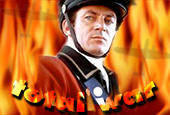lastdingo
Posts: 110
Joined: 7/31/2006
Status: offline

|
You didn't read properly.
quote:
Strategic bombers are bombers that bomb strategic targets. Strategic is the role they play and doesnt imply range although most strategic targets are deep within enemy territory.
Saddling the horse from the other side doesn't mean I was wrong. Your definition on the other hand is wrong, for not all bombers that bombed strategic targets were called strategic bombers. No matter which period we're looking at.
The again, the definition isn't that important, as I mentioned 'strategic bombers' merely as an introduction to the dynamics of combat aircraft design at the time.
quote:
The reason medium and light bombers weren't used in the strategic bombing campaign is because they weren't heavy bombers with heavy bomb carrying capacities.
Actually, they were used in the strategic bombing campaign. Benelux and French industries were frequently targeted with light and medium bombers for lack of better targets for them. Mosquitos were used as well.
quote:
Not to mention the fact that light and medium bombers would have to bomb at higher altitudes to get out of german flak, which would mean less accuracy and more raids and more deaths over the same target.
Not at all. RAZON and Fritz-X were usable out to 30,000 ft altitude AND vulnerability to heavy AAA is a function of altitude, maneuvers, aircraft hardware, electronic combat, clouds, formation and time in range. Few fast bombers dropping guided bombs would have reduced the effect of heavy AAA to a tiny fraction of their historical value. No aircraft was ever reported shot down by heavy AAA during Fritz-X missions, for example (no matter how often keyboard generals claim that the aircraft was vulnerable because of flying straight - in fact, the bombers were in a shallow climb after release and thus quite difficult to target accurately).
quote:
First you say british bombers were tactically unimpressive, I show some examples, you agree and then start to talk about how ineffective the raids are
1% of missions is hardly representative. 1% sophistication is even less impressive if it's rarely able to shine in cost/benefit ratio next to brute force. There were more botched special attacks than successful ones, after all.
quote:
5)Tactics should follow doctrine. If Bomber Command has the doctrine of area bombing, it's heavy bombers are going to reflect that.
Both doctrine and tactics were primitive. So what?
quote:
- belly turrets (ventral attacks were ineffective until the introduction of Schräge Musik, even then they were used in small numbers.
Actually, ventral attacks were universally preferred against targets that were able to watch their six. This applies to daylight just as to nighttime. German nightfighters considered the direct 6 o'clock attack as a terrible necessity when the spotting distance was so short that no ventral attack was possible (= bomber already in firing range when spotted visually for the first time).
quote:
- mix with 50cal and 20 mm guns to force the nightfighters to adopt heavier frontal armour (this isn't daylight bombing, night fighters didn't do frontal attacks)
I wrote about night fighter frontal armour, not bomber frontal armour. Concentrate!
quote:
- use of much higher cruise and attack altitudes (once again, this isnt daylight bombing AAA is ineffective if you cant see what you're shooting at.)
What? Bomber Command suffered heavily due to their medium altitude attacks. All heavy AAA was highly lethal to them 1942-1945 as long as ammo was available and the radars worked. The angle error of German fire control radars was on the order of 0.2°, about the same as shell dispersion and easily enough for effective blind fire.
Flying higher would ceteris paribus have reduced AAA effectiveness and it would have put greater requirements on nightfighter designs and its trade-offs.
quote:
- earlier compression of time over target to less than 20 minutes in order to minimize the qty of AAA shells fired ( they attacked in streams,which is safer to fly in than in concentrated boxes.)
...and you have apparently little clue about Bomber Command tactics.
Sometime in 1943 operational research calculated that compressing the time over target for the bomber stream would leave the heavy AAA less time for their job = less losses. Crews were concerned about risk of collisions - operational research calculated an average of one collision per 1,000 bomber raid and during the first test OR was proved correct in all regards. This simple compression of time over target reduced losses to AAA greatly (quite the same logic as applied against the Himmelbett network). It came quite late, though.
Bomber streams doesn't mean that bombers could not arrive over the target at the same time. You split them up and let the sub-streams fly over the target in a 10-20 minute time frame.
Now don't call this sophisticated; it was still primitive in comparison to a Japanese or German torpedo bomber attack (Japanese used prong attacks against capital ships, Germans preferred a few minutes short time window at dusk to hit convoys hundreds of miles away from their bases!).
quote:
- more use of Mosquitos for the attack on heavy AAA batteries (remember its nighttime, and you already said Mossy raids "were all ineffective" and Bomber Command was primitive)
The small harrassing raids of 1-3 Mosquitos against a city were strategically unimportant (albeit kinda cost-effective due to their minimal costs), yes.
Their potential in SEAD was greater as long as one believes in big nighttime raids at all.
quote:
- more elaborate paths (not elaborate according to you)
The Bomber Command missed many opportunities to counter Zahme Sau with more elaborate bomber stream paths.
Almost all that they did was avoiding major AAA regions, focusing on breaking through Himmelbett on a minimum of Himmelbett sectors and then the aforementioned timing over the target city itself. They did rarely design paths in order to reduce Zahme Sau effectiveness.
quote:
- attacks on the big stationary early warning radars (some of those weren't attacked until '45!!!) (you cant hit what you cant see.)
WTF? Why couldn't you see a big radar?
I didn't mean daylight attacks (those big radars were on the coast and vulnerable to low level raids of Mosquitos), but even nighttime attacks were easily possible - especially in Oboe range. Light low level interdiction bombers even flew missions between mountains at night - trying to kill difficult targets such as trains or trucks.
All you need is absence of low clouds, moon or a bit area illumination and then a handful of low-flying light or medium bombers.
Besides; it was also possible to build passive radar homing glide bombs during WW2. In fact, some were developed and the Americans even fielded an active radar homing glide bomb.
quote:
Stupid strategy? Just because you don't understand something doesn't make it stupid.
Actually, after reading so much and having the advantage of hindsight, I'm pretty confident that I understand that primitive "strategy" and its failure. It led to great destruction, but it did next to nothing to accelerate VE or reduce overall Allied casualties.
The British had the classic "we need to do something" problem and lacked the self-discipline to not do primitive stuff in addition to promising stuff.
The result was that they had committed huge war crimes and spent great fortunes that haunted them fiscally during the post-wartime.
< Message edited by lastdingo -- 11/30/2011 12:57:09 AM >
|
 Printable Version
Printable Version

 to blame for the destruction of the whole oil production
to blame for the destruction of the whole oil production .
.  It would be nice of the guys
It would be nice of the guys









 , is that by historical '44 like you start in the oil short campaign the situation was already desperate many months ago so it is only logical that I'm so frustrated about having to watch as the glorious factories of the state get turned into parking lots and have to see all my fighters get hammered by the godless allied war machine...it probably would have been a good idea to have an scenario editor, an small campaign for '43 in which you don't need to guard the whole of Europe or even one after '41 in which you could produce, given the warm mantle of hindsight, only the planes that you already know would have a good bang for mark ratio.
, is that by historical '44 like you start in the oil short campaign the situation was already desperate many months ago so it is only logical that I'm so frustrated about having to watch as the glorious factories of the state get turned into parking lots and have to see all my fighters get hammered by the godless allied war machine...it probably would have been a good idea to have an scenario editor, an small campaign for '43 in which you don't need to guard the whole of Europe or even one after '41 in which you could produce, given the warm mantle of hindsight, only the planes that you already know would have a good bang for mark ratio. 
 .
. 

 New Messages
New Messages No New Messages
No New Messages Hot Topic w/ New Messages
Hot Topic w/ New Messages Hot Topic w/o New Messages
Hot Topic w/o New Messages Locked w/ New Messages
Locked w/ New Messages Locked w/o New Messages
Locked w/o New Messages Post New Thread
Post New Thread